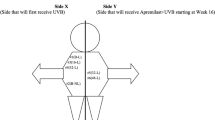Abstract
Background
New targeted melanoma therapies such as B-RAF inhibitors have shown high and promising clinical benefit but have cutaneous side-effects, including photosensitivity, which is triggered in the UVA radiation spectrum. However, visible spectrum implication has not yet been investigated.We conducted a study to determine whether visible light also contributes to the phototoxicity action spectrum of vemurafenib. The secondary end points were to determine the time to complete regression of the phototoxicity post-vemurafenib discontinuation and whether there was a significant difference between the UVA radiation immediate reactivity cut-offs, in patients treated with vemurafenib vs. those treated with dabrafenib.
Method
This prospective, observational study included patients with B-RAF mutant metastatic melanoma: 34 patients treated with vemurafenib and 9 with dabrafenib.
Results
The visible-light phototest results in patients treated with vemurafenib were all negative before and after 2 months of treatment. The UVA radiation phototests conducted 1 or 2 weeks post-vemurafenib discontinuation in 4 patients showed a normalised UVA-radiation reactivity cut-off. UVA radiation phototests after 2 months of treatment were conducted for all patients. The UVA radiation reactivity cut-off had been lowered for 30 patients (88%) on vemurafenib and 3 patients (33%) on dabrafenib. The median UVA radiation reactivity cut-off was 12 J/cm2 for the patients on vemurafenib and 20 J/cm2 for the patients on dabrafenib.
Conclusion
B-RAF inhibitor phototoxicity is exclusively triggered byUVAradiation and resolves rapidly post-treatment discontinuation. A significant difference between the UVA immediate reactivity cut-offs, vemurafenib vs. dabrafenib, explains the difference in the clinical photosensitivity rates reported in the clinical trials.
Similar content being viewed by others
References
Chapman PB, Hauschild A, Robert C, et al. Improved survival with vemurafenib in melanoma with BRAF V600E mutation. N Engl J Med 2011; 364: 2507–16.
Hauschild A, Grob J-J, Demidov LV, et al. Dabrafenib in BRAFmutated metastatic melanoma: a multicentre, open-label, phase 3 randomised controlled trial. Lancet 2012; 380: 358–65.
Anforth R, Fernandez-Pe˜nas P, Long GV. Cutaneous toxicities of RAF inhibitors. Lancet Oncol 2013; 14: e11–8.
Flaherty KT, Puzanov I, Kim KB, et al. Inhibition of mutated, activated BRAF in metastatic melanoma. N Engl J Med 2010; 363: 809. 19.
Sosman JA, Kim KB, Schuchter L, et al. Survival in BRAF V600-mutant advanced melanoma treated with vemurafenib. N Engl J Med 2012; 366: 707–14.
Ascierto PA, Minor D, Ribas A, et al. Phase II trial (BREAK-2) of the BRAF inhibitor dabrafenib (GSK2118436) in patients with metastatic melanoma. J Clin Oncol 2013; 31: 3205–11.
Dummer R, Rinderknecht J, Goldinger SM. Ultraviolet A and photosensitivity during vemurafenib therapy. N Engl J Med 2012; 366: 480. 1.
Gelot P, Dutartre H, Khammari A, et al. Vemurafenib: an unusual UVA-induced photosensitivity. Exp Dermatol 2013; 22: 297–8.
Brugière C, Stefan A, Morice C, Cornet E, Moreau A, Allouche S, et al. Vemurafenib skin phototoxicity is indirectly linked to ultraviolet A minimal erythema dose decrease. Br J Dermatol 2014; 171: 1529–32.
Du-Thanh A, Debu A, Lalheve P, Guillot B, Dereure O, Peyron J-L. Solar urticaria: a time-extended retrospective series of 61 patients and review of literature. Eur J Dermatol 2013; 23: 202–7.
Boussemart L, Routier E, Mateus C, et al. Prospective study of cutaneous side-effects associated with the BRAF inhibitor vemurafenib: a study of 42 patients. Ann Oncol 2013; 24: 1691–7.
Mattei PL, Alora-Palli MB, Kraft S, Lawrence DP, Flaherty KT, Kimball AB. Cutaneous effects of BRAF inhibitor therapy: a case series. Ann Oncol 2013; 24: 530–7.
Moseley H, Naasan H, Dawe RS, Woods J, Ferguson J. Population reference intervals for minimal erythemal doses in monochromator phototesting. Photodermatol Photoimmunol Photomed 2009; 25: 8–11.
Béani JC. [Interpretation of photobiologic tests]. Ann Dermatol Venereol 1987; 114: 123–6.
Committee for Medicinal Products for Human Use (CHMP). Assessment Report of Zelboraf, vemurafenib. EMA/CHMP/926998/2011. 2011.
FDA/Center for Drug Evaluation and Research, Division of Drug Oncology Products (HFD-150) 2011. Pharmacology and Toxicology NDA Review and Evaluation of Zelboraf, vemurafenib. 2011.
Boudon SM, Plappert-Helbig U, Odermatt A, Bauer D. Characterization of vemurafenib phototoxicity in a mouse model. Toxicol Sci Off J Soc Toxicol 2014; 137: 259–67.
Shah N, Iyer RM, Mair H-J, et al. Improved human bioavailability of vemurafenib, a practically insoluble drug, using an amorphous polymer-stabilized solid dispersion prepared by a solvent-controlled coprecipitation process. J Pharm Sci 2013; 102: 967–81.
Author information
Authors and Affiliations
Corresponding author
About this article
Cite this article
Gabeff, R., Dutartre, H., Khammari, A. et al. Phototoxicity of B-RAF inhibitors: Exclusively due to UVA radiation and rapidly regressive. Eur J Dermatol 25, 452–456 (2015). https://doi.org/10.1684/ejd.2015.2628
Accepted:
Published:
Issue Date:
DOI: https://doi.org/10.1684/ejd.2015.2628




